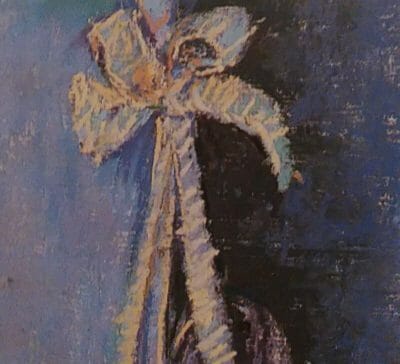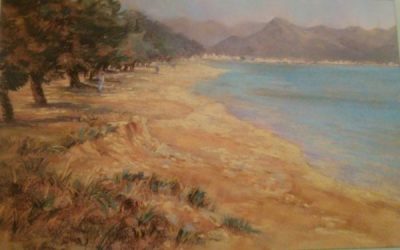Beginner painters very are very often troubled when it comes to drawing white objects as summer clouds, snow, seafoam white buildings or white clothes on subjects they are painting. Faced with the problem they use white to paint light areas and grey to paint the shadows.
The result is monotonous painting unable to capture the brightness and shine of the subject. This usually happens when a painter does not know what he sees so he paints what he thinks he sees. So how to draw white objects so they don’t look dull and uninteresting?
If you observe the white object closely, especially on a sunny day you will realise it contains surprisingly many colors that o from warm pink, yellow and gold on bright places to cold blue, purple and green in the shadows.
Theses delicate nuances are not obvious at first but those unexpected color flashes are exactly what emphasizes the whiteness of white surfaces. Whiteness does not contain any colours but it reflects the surrounding color so it is never completely white but consists of many other colors.
White snow, for example, might seem yellowish on a sunny day while the shadows that are on it seem blue or purple since they reflect the sky.
Similar to that shadows on white clothes might seem blue or purple outside on a sunny day but inside under artificial light, they get a greenish and yellowish tone.
Pastels are very good for drawing the white areas imbued with color. By adding layers of color one over the other you can indicate small traces of many colors.
If you gradually develop your painting with small moves of scattered paint you will give your painting or drawing flickering quality that depicts the subtle play of light and shade and creates complex layers that are much more lively than the simple white surface.
Ballet Shoes
Artists that work with pastels more often work on colored surface but the white surface can be great for delicate themes. You can use the whiteness of the paper to your advantage letting it be seen through the color interrupting it. This way the object you draw will get that airy flickering impression you want it to have.
The materials you will need for this drawing are:
- A sheet of white paper
- Drawing board and tape
- Charcoal stick or pencil
- Clean rag or paper towels
You will need soft pastels in the following colors:
- A lighter nuance of sky blue
- A lighter nuance of cobalt blue
- A middle nuance of ultramarine blue
- Dark grey-blue
- Pale purple
- A middle nuance of purple
- Dark purple
- Cream lemon yellow
- Light yellow
- A light nuance of orange
- Pale cream
- A light nuance of viridian green
Sketching
Sketch the ballet shoes using charcoal. Use a clean rag to wipe off all unnecessary moves and charcoal residue so it doesn’t smear the colors. Cover the entire surface of the background with pale tones of sky blue and cobalt blue. Break a little piece of paste and using the side not the tip cover the paper with even tone.
Over that ad dark areas in order to create the impression of light and shadow. First, use middle ultramarine blue and then cover it with dark purple and dark grey-blue for the darkest shadows next to the ballet shoes. Rub the edges with your fingertips gently to remove any sharp moves.
Ad details to ballet shoes using three different nuances of purple. Inside of the shoes draw with middle purple, then cover it with dark purple to get a deep shadow. For the ribbons and tips of the shoes use a very pale nuance. Ad the paint lightly allowing the whiteness of the paper to go through it.
Adding The Details
Add a little bit of pale green on the outer side of the ribbons and on the edges of the shoes on the areas where the light is on them. With cream lemon yellow hatch the ridges and the ribbons. Use a little bit of pale orange for shadows and ridges on the bend.
To make the tips of shoes lighter use cream lemon yellow and light yellow. The base layer of pale purple pastel on the bend will go through when you add the viridian green, orange and yellow with lively strong moves. That works quite well with pastels giving a flickering quality to the object.
Using pale nuance of viridian green draw the contour of the shoes to point them out more. To do that break a piece of the pastel stick and use the tip to draw. Notice how the rough texture of the paper breaks the line while you’re drawing giving the colors shimmering quality.
Finishing Touches
It is time to add the finishing details to complete your drawing. Observe your drawing to realise where you need to make it darker and where lighter. Add a glimpse of shadows on the tips of ballet shoes with light moves of viridian green and cobalt blue.
Draw glimpses of cobalt blue around the edges of ballet shoes and inside the shadows. To add lighter areas on the tips of the shoes use cream lemon yellow and pale cream. With the tips of your fingers slightly smear the hatching on the strings, different colors and tone will mix when you do that and will give the impression of shiny satin.
Now carefully blend the colors on the tips of ballet shoes with your fingertips to give them the same satin shine as you given the strings. Be careful not to overdo it, leave some traces of hatching because it creates a more lively impression that uniform blended color.
Draw small bows on the front of the ballet shoes. For that use light yellow for lighter areas and cobalt blue for shadows. You will need small pieces of pastel sticks with sharp tips to draw the fine thin lines. In the end, add just a few lines with dark purple around the edges of ballet shoes to point them out more and separate them from the background.
After you finished and you feel like there is nothing else to ad spray your drawing with spray fixative to protect it from smearing. Make sure that you do it from a distance so you don’t smear it when applying the fixative. Wait for the first layer to dry properly so it is completely dry to touch and then add another layer in the opposite direction from the first one.









0 Comments